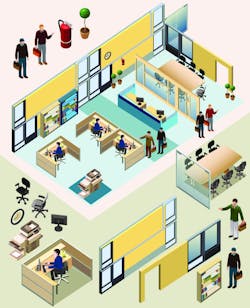Encompassing indoor-air quality (IAQ), thermal quality, and lighting quality, indoor environmental quality (IEQ) impacts the comfort, well-being, and productivity of building occupants. It is a “perceived” experience,1 one affected by factors such as space design, equipment vibration, acoustics, and aesthetics.
Codes and standards contain minimum requirements intended to ensure buildings do not impair occupant health and comfort. Environmental-quality optimization is a concept aimed at improving occupant health and comfort. As this article will discuss, by intelligently exceeding codes and standards, we not only get by, we get ahead.
It is important to note some environmental-quality-optimization measures can be implemented during lighting retrofits for little or no additional cost. Others can be adopted during interior renovation or through modification of HVAC systems and HVAC-system operation. Many such measures can perform double duty, also serving as part of an energy-management program.
Space Design
Space design influences personal interaction, and personal interaction influences individual health and well-being. For example, research shows noise levels are higher and privacy and worker satisfaction lower with open floor plans than with other office designs.2 Workers in open-plan offices take 36 percent to 62 percent more sick days than workers in cell offices.3
Social contact is greater with open floor plans. Detailed studies of flu propagation suggest increasing social distance reduces flu spread.4 A savvy designer can use targeted, science-based approaches to measurably reduce office sickness rates and absenteeism, helping to change the mistaken impression work-performance parameters are just another “fixed cost.”
Harnessing Germicidal Forces
Many serious communicable diseases are transmitted person to person via airborne contact. For example, influenza primarily is transmitted from person to person via large (more than 5 microns in diameter) virus-laden droplets generated when infected persons cough or sneeze. These droplets settle on the mucosal surfaces of the upper respiratory tracts of persons within 3 ft. The latest research on sneezing and coughing from the Massachusetts Institute of Technology shows clouds of small aerosols created by sneezing can travel much farther than once thought: up to 6 m in the form of large droplet and tiny aerosol particles.5
The airborne spread of disease among workers in office settings can be prevented with increased ventilation. For new construction and major renovations, additional fresh-air-treatment equipment, energy recovery, or a dedicated outdoor-air system may be justified. (To learn more, read the authors’ March 2010 HPAC Engineering article, “The Case for Increased Ventilation.")
Also effective is the installation of high-intensity ultraviolet (UV) emitters downstream of air-conditioning coils. This has the added benefit of keeping coils clean and reducing fan energy costs. (To learn more, read Forrest Fencl’s July 2013 HPAC Engineering article, “Maintaining A/C-System Performance With UV-C.”) UV emitters also can be used to eliminate mold from the wettest parts of air handlers. When fungal colonies “bloom,” they produce spores by the millions, which can be distributed throughout a building by the air-conditioning system, aggravating allergies and asthma among occupants.
In a typical office environment, pathogens hide in plain sight on surfaces such as doors and tables, waiting to be picked up by healthy employees. The flu virus, for instance, can live on hard surfaces for up to two days—much longer if it is mixed with human mucous.6 Transmission occurs when a person touches a contaminated surface and then touches his or her eyes, nose, or mouth. Employers can combat this by encouraging handwashing. Handwashing reduces total viral load, as well as transfer rate.7 Employers also can encourage the use of face masks, as is done in many Asian countries. Masks help to prevent the spread of disease and could be considered as a health-care loss-prevention tool under certain circumstances.
The modern flush toilet is a veritable fountain of germs, launching large droplets and clouds of tiny particles with each activation.8 Small particles desiccate and can remain suspended and viable for long periods. Bacterial endospores can contaminate air and surfaces long distances from toilets, with dormant spores remaining viable indefinitely. Particle production increases with toilet energy: High-energy toilets, such as flushometers, emit 12 times more liquid aerosol than lower-energy, higher-efficiency toilets.9 Conventional disinfection practices, meanwhile, actually increase particle emissions: Modern detergent products reduce surface tension, which creates more small particles, and fail to kill microbes.8 Building managers should consider equipment choices carefully and be alert for emerging remedies, such as high-surface-tension cleaners. In the meantime, building owners can reduce the risk of disease transmission by:
- Adopting low-energy flush toilets to reduce aerosolization of flushed contents.
- Ventilating toilets from top to bottom, with ceiling supplies balanced to maintain negative pressure.
- Ensuring bathroom negative pressure is operative and as high as feasible.
- Moving bathroom exhausts to directly behind toilets and increasing face velocity to 500 fpm to capture toilet plumes.10
- In critical-care settings, considering MERV 16 filters for bathroom exhaust to prevent dissemination of infective aerosols.
- Considering higher-intensity ultraviolet-C (UV-C) at about 12,000 microwatt-seconds per square centimeter, standard for HVAC irradiation. (To learn more, read Forrest Fencl’s October 2013 HPAC.com article, “Rightsizing UV-C Lamps for HVAC Applications.”)
Germicidal Copper
We know pulsed-xenon, broad-spectrum UV light can kill microbes on surfaces. However, self-cleaning surfaces are a simpler parallel approach suitable for any building.
Clean copper (including brass, bronze, and copper-nickel alloy) surfaces kill deposited pathogens, rather than hold them for the next victim, at no risk to humans. Since 2008, the U.S. Environmental Protection Agency has registered more than 475 copper-containing surfaces that, when used in accordance with labeling, kill 99.9 percent of bacteria within two hours. In hospital rooms, copper touch surfaces have been shown to reduce hospital-acquired infections by 58 percent. ECRI Institute estimates a one-year return on investment for hospital adopters of copper touch surfaces.11
Antimicrobial touch surfaces can break the transmission chain within minutes to hours and every time new microbes are deposited. So, to reduce absenteeism and associated medical costs from colds and flu and other communicable diseases, take a look at doorknobs, restroom fixtures, and breakroom and conference-room surfaces, and consider converting to antimicrobial copper.
Thermal Comfort
ANSI/ASHRAE Standard 62.1, Ventilation for Acceptable Indoor Air Quality, specifies “minimum ventilation rates and indoor air quality that will be acceptable to human occupants and are intended to minimize the potential for adverse health effects.” Acceptable IAQ is defined as “air in which there are no known contaminants at harmful concentrations as determined by cognizant authorities and with which a substantial majority (80 percent or more) of the people exposed do not express dissatisfaction.” Meeting ANSI/ASHRAE Standard 62.1, then, means one out of five occupants may be dissatisfied. Similarly, ANSI/ASHRAE Standard 55, Thermal Environmental Conditions for Human Occupancy, specifies “the combination of indoor space environment and personal factors that will produce thermal environmental conditions acceptable to 80 percent or more of the occupants within the space.”
Standard 55 recognizes an optimum condition is only partly a function of air temperature; it also is a function of each individual’s heat balance, which is shaped by air speed, clothing, gender, metabolic status, etc. This is why there is a considerable range of occupant satisfaction at any given air temperature. It also is why there can be so much conflict over temperature setting; everyone’s heat balance differs, so everyone is “right” in an air-temperature dispute. The U.S. General Services Administration identified HVAC systems that allow employees to control the workplace climate as a major factor affecting office design. Peace can reign only when individuals control their own HVAC settings and match their heat balance with the range of air temperatures available through individual controls. Otherwise, studies show, uncomfortable workers adjust their work output to minimize errors resulting from thermal discomfort. This is why the effect of thermal discomfort shows up in productivity studies.
Illuminating Your Health
Light level, color, intensity, and timing affect visual functioning, alertness, cognitive function, brainwave activity, and sleep regulation. Light’s potent effects on the body are mediated through newly discovered light-sensitive but non-imaging cells12 in the retina that are wired directly to different areas of the brain and sometimes to rods and cones used for imaging vision.13 Increased understanding of the wider functioning of the visual system has led to new ways to manage buildings to promote better performance, sleep habits, and psychological functioning of employees through relatively simple changes in building lighting systems and operational procedures.
If you ever have completed a work assignment late at night, you might have been unable to sleep for several hours after turning off your computer. That is because of the bright bluish light of your screen, which shifted your sleep cycle forward and alerted your body in a number of different ways.14 Similarly, nighttime smartphone use increases depletion the next morning via its effects on sleep, and morning depletion diminishes daily work engagement.15 Much of this effect likely is the result of the intense mental engagement and bluish light of smartphones.
Melatonin levels are suppressed in response to blue light coming into the eye and stimulating retinal ganglion cells wired directly to the brain’s clock-control center in the hypothalamus.
We now know the dose and specific colors (wavelengths) causing this response for several non-imaging functions, making development of lighting schemes that optimize alertness and shift the circadian rhythm and sleep cycles possible.
Sleep disturbance caused by shift work, which affects about 20 percent of U.S. workers, could be partially addressed through manipulation of lighting regimes. Strategies involve changing light color, light intensity, and duration, controlling light levels, and having workers travel to and from work wearing tinted goggles or sunglasses. Light therapy has been shown to help nurses adapt to constantly changing day/night routines that disrupt their internal clock (circadian rhythm).
One’s internal clock also can be disrupted by windowless offices, too-blue computer screens, lighting at the wrong time of day, late-night blue lighting, and overly bright late-night lighting. Disruption has health-care, performance, and absenteeism costs. The good news is that we can revise light strategies and combine them with energy-conservation strategies related to daylighting, lighting retrofits, and modified work-related mobile-device apps to help employees get on track. Lighting retrofits, including ergonomics, can help to resolve conflicts between desk-work and screen-work light levels, resolve glare, restore employee control over lighting, and achieve additional benefits.
Conclusion
A growing body of evidence indicates buildings can be actively managed to improve occupant health, productivity, and well-being. Managing ventilation, light, building surfaces, and other environmental conditions can reduce disease transmission and improve human physiological functioning. Informed building professionals can implement some no/low-cost strategies as part of their normal operating practices. By understanding the range of correctable problems related to IEQ, as well as the tools available to address them, building professionals can help employers to recognize new opportunities to reduce absenteeism, presenteeism, and health-care costs, even when such costs are viewed as fixed. The principles are simple, the knowledge is powerful, and the impacts are beneficial to all.
References
- ASHRAE terminology. (n.d.). Retrieved from https://www.ashrae.org/resources--publications/free-resources/ashrae-terminology
- De Croon, E.M., Sluiter, J.K., Kuijer, P.P., & Frings-Dresen, M.H. (2005, February). The effect of office concepts on worker health and performance: A systematic review of the literature. Ergonomics, pp. 119-134.
- Pejtersen, J.H., Feveile, H., Christensen, K.B., & Burr, H. (2011). Sickness absence associated with shared and open-plan offices – a national cross sectional questionnaire survey. Scandinavian Journal of Work, Environment & Health, 37, 376-382.
- Kar-Purkayastha, I., Ingram, C., Maguire, H., & Roche, A. (2009, August 20). The importance of school and social activities in the transmission of influenza A(H1N1)v: England, April - June 2009. Eurosurveillance, 14, 127-136.
- Bourouiba, L., Dehandschoewercker, E., & Bush, J.W.M. (2014, April). Violent expiratory events: on coughing and sneezing. Journal of Fluid Mechanics, pp. 537-563.
- Owen, T. (n.d.). How long does the flu virus live on surfaces? Retrieved from http://www.ehow.com/about_5435217_long-flu-virus-live-surfaces.html
- Julian, T.R. (2010). Fomites in infectious disease transmission: A modeling, laboratory, and field study on microbial transfer between skin and surfaces. Dissertation.
- Traverso, G., Laken, S., Lu, C.-C., Maa, R., Langer, R., & Bourouiba, L. (2013). Fluid fragmentation from hospital toilets.
- Johnson, D., Lynch, R., Marshall, C., Mead, K., & Hirst, D. (2013). Aerosol generation by modern flush toilets. Aerosol Science and Technology, 47, 1047-1057.
- Welty, S. (2011, August). Solving indoor airborne disease transmission problems. Engineered Systems, pp. 55-61.
- ECRI Institute. (2014). ECRI Institute’s 2014 top 10 hospital c-suite watch list.
- Berson, D. (2007). Phototransduction in ganglion-cell photoreceptors. European Journal of Physiology, 454, 849-855.
- Schmidt, T.M., Chen, S-K., & Hattar, S. (2011). Intrinsically photosensitive retinal ganglion cells: Many subtypes, diverse functions. Trends in Neurosciences, 34, 572-580.
- Nelson, J.P., Redman, J.R., Schlangen, L.J.M., & Rajaratnam, S.M.W. (2009). Blue light exposure reduces objective measures of sleepiness during prolonged nighttime performance testing. Chronobiology, 26, 891-912.
- Lanaj, K., Johnson, R.E., & Barnes, C.M. (2014, May). Beginning the workday yet already depleted? Consequences of late-night smartphone use and sleep. Organizational Behavior and Human Decision Processes, pp. 11–23.
David Harlos, ScD, is an indoor-air-pollution scientist with more than 20 years of experience encompassing governmental regulation, consulting, and university research. He served on the faculty of the Harvard School of Public Health and managed a national air-toxin-sampling network for the U.S. Environmental Protection Agency. He is an active member of the Air & Waste Management Association and the American Industrial Hygiene Association. A member of HPAC Engineering’s Editorial Advisory Board, Michael West, PhD, PE, is a building-systems scientist who investigates and engineers solutions to high-energy-cost, maintenance, and comfort concerns. A recipient of the Association of Energy Engineers’ (AEE’s) International Project of the Year and the U.S. Department of Defense’s Environmental Security Technology Certification Program Energy and Water Project of the Year awards, he has extensive experience applying renewable sources of energy and directing the development and testing of cutting-edge HVAC technologies. He is an active member of AEE and ASHRAE.
Did you find this article useful? Send comments and suggestions to Executive Editor Scott Arnold at [email protected].










